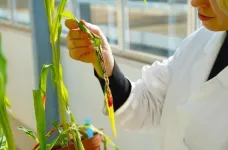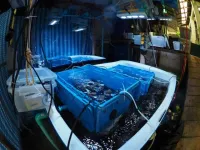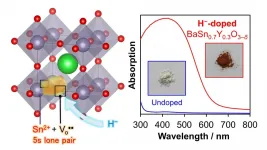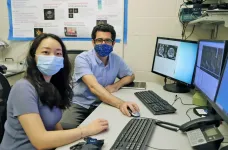The African wild dog: An ambassador for the world's largest terrestrial conservation area
2021-05-07
(Press-News.org) Dispersal is an important process governing the persistence of wild animal populations. Upon reaching sexual maturity, individuals usually disperse from their natal home range to search for suitable habitat and mates for reproduction. As such, dispersal promotes gene flow among populations, allows rescuing small and isolated populations, and enables the colonization of unoccupied habitats. In human-dominated landscapes, however, dispersing animals find it increasingly difficult to cross densely populated areas that separate suitable habitats. For this reason, the identification and preservation of wildlife corridors has become of utmost importance for conservation authorities worldwide.
In southern Africa, the governments of Angola, Botswana, Namibia, Zambia and Zimbabwe have agreed to preserve an unprecedented network of wildlife corridors, connecting up to 35 already-existing national parks, game reserves and other protected areas. The Kavango-Zambezi Conservation Area (KAZA) spans roughly 520,000 square kilometers, making it the world's largest terrestrial conservation area. But do the boundaries of the KAZA match the dispersal behavior of the species it seeks to protect? Researchers at the University of Zurich sought to answer this question by studying the African wild dog (Lycaon pictus), the most endangered and most mobile species in the KAZA.
Critically endangered large predator
African wild dogs currently number around 6,000 free-ranging individuals acrossa few remaining populations in southern and eastern Africa. Wild dogs live in packs of up to 30 individuals that are led by one dominant couple. After reaching sexual maturity, wild dogs disperse in an attempt to find potential mates and suitable territory to settle. Similar to wolves, wild dogs can cover hundreds of kilometers during this journey.
"We wanted to find out how and where dispersing wild dogs move and investigate whether the different populations within the Kavango-Zambezi Conservation Area are able to connect with each other," says David Hofmann, first author of the study and PhD student at the Department of Evolutionary Biology and Environmental Studies. For this purpose, the UZH research team put GPS collars on several wild dogs and used the tracking data to find out which habitats dispersers prefer to cross and ultimately to predict which areas contain suitable wildlife corridors.
Very few corridors outside the conservation area
The results suggest that most of the identified wildlife corridors are located within the KAZA, with northern Botswana appearing to act as a central hub for dispersing individuals. Another important corridor connects national parks in Angola and Zambia. "While the corridor still runs through areas that are largely unprotected, the KAZA initiative does intend to place these zones under protection," says Hofmann. "There's still potential for expansion though as several suitable dispersal routes remain currently uncovered by the KAZA."
Not all areas are equally suitable for establishing wildlife corridors. In some countries, dispersers encounter little obstacles during dispersal, whereas in countries such as Zambia and Zimbabwe, high population densities and associated activities hinder animal movements. The researchers have thus urged that these country-specific differences have to be taken into consideration when implementing the KAZA initiative.
Lions and elephants also stand to benefit
The statistical methods and movement data employed in this study will not only be of use to decision-makers involved with the KAZA initiative, but can also be used to create new protected areas or to modify existing zones. The researchers' findings emphasize that the Kavango-Zambezi Transfrontier Conservation Area largely meets the needs of dispersing African wild dogs, thereby making an important contribution to conserving this endangered species in southern Africa. "Ultimately, expanding the network of wildlife corridors doesn't just help African wild dogs. Other species that live in the same ecosystem such as lions, elephants and cheetahs are also likely to benefit," says Hofmann.
INFORMATION:
Literature:
David D. Hofmann, Dominik M. Behr, John W. McNutt, Arpat Ozgul, Gabriele Cozzi. Bound within boundaries: Do protected areas cover movement corridors of their most mobile, protected species? Journal of Applied Ecology. 7 May 2021. DOI: 10.1111/1365-2664.13868
About the KAZA initiative
Southern Africa is home to the world's largest terrestrial conservation initiative: the Kavango-Zambezi Transfrontier Conservation Area (KAZA). Stretching across Angola, Botswana, Namibia, Zambia and Zimbabwe, the KAZA covers an area of around 520,000 square kilometers, making it larger than Germany, Austria and Switzerland combined. This unprecedented initiative seeks to connect a total of 35 already-existing national parks, game reserves and other protected to preserve a dense network of wildlife corridors for populations of endangered species. The KAZA will be formally established based on an international treaty between the participating African countries.
https://www.kavangozambezi.org/en/about/about-kaza
[Attachments] See images for this press release:
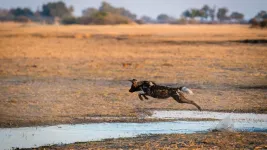
ELSE PRESS RELEASES FROM THIS DATE:
2021-05-07
Inclusion of soybean and linseed oils in the diet of dairy cows made the fatty acid content of their milk even healthier for human nutrition. It also increased the proportions of omega-6 and omega-3, which in the right balance play a key role in preventing cardiovascular diseases, for example, as well as chronic inflammation and some kinds of cancer.
Cardiovascular diseases are one of the world’s main public health problems. In Brazil, they are among the foremost causes of death. Each year some 300,000 Brazilians have heart attacks, dying in 30% of cases, according to the Health Ministry.
Research led by Arlindo Saran Netto, a professor at the University of São Paulo’s School of Animal Science and Food Engineering (FZEA-USP) in Pirassununga, São Paulo ...
2021-05-07
People spend about 80-90% of their time indoors. Compared to outdoor air quality, the indoor air quality is more relevant to people's health. Therefore, understanding the levels, sources and evolution of particulate matter (PM) indoors is important for the accurate evaluation of people's health risks to aerosol exposure.
A research team led by Prof. Yele Sun from the Institute of Atmospheric Physics (IAP) of the Chinese Academy of Sciences deployed a time-of-flight aerosol chemical speciation monitor (ToF-ACSM) to measure time series and mass spectra of non-refractory species in a typical academic office in IAP. The study was published in Indoor Air.
The researchers measured the concentration and chemical composition of indoor PM2.5 ...
2021-05-07
To understand the world, we arrange individual objects, people, and events into different categories or concepts. Concepts such as 'the telephone' consist primarily of visible features, i.e. shape and color, and sounds, such as ringing. In addition, there are actions, i.e. how we use a telephone.
However, the concept of telephone does not only arise in the brain when we have a telephone in front of us. It also appears when the term is merely mentioned. If we read the word "telephone", our brain also calls up the concept of telephone. The same regions in the brain are activated that would be activated ...
2021-05-07
To infect its host plant maize, the fungal parasite Ustilago maydis uses a complex of seven proteins. Numerous findings reveal an essential role of the complex in causing disease and suggest a widespread occurence in fungal plant pathogens.
Each year, fungal plant pathogens such as rusts, rice blast and mildews destroy huge amounts of cereal crops that could feed millions of people. Many of these fungi are biotrophic pathogens: Instead of killing their host plants, they manipulate host cells to assure that these sustain fungal growth. Among these pathogens, the corn smut fungus Ustilago maydis has emerged as a model for basic research on biotrophic fungi.
During the infection, U. maydis releases an entire cocktail of so-called ...
2021-05-07
7 May 2021/Kiel. Corals are the backbone of marine ecosystems in the tropics. They are threatened by rising water temperatures caused by global warming and they are among the first ecosystems worldwide that are on the verge of ecological collapse. Coral bleaching, which is becoming stronger and more frequent due to heat stress, has already wiped out corals at many locations globally. With the help of a microbiome-targeting strategy developed by an international team led by GEOMAR Helmholtz Centre for Ocean Research Kiel, it could become feasible to help protect corals from heat stress. The work has now been published in the international journal Microbiome.
Corals are the backbone of marine ecosystems in the tropics. They are threatened by rising water temperatures caused by global warming ...
2021-05-07
Narrow-gap semiconductors with the ability to use visible light have garnered significant interest thanks to their versatility. Now, scientists in Japan have developed and characterized a new semiconductor material for application in process components stimulated by light. The findings have, for the first time, suggested a new way to reduce the band gap in cheaper and non-toxic tin-based oxide semiconductors for efficient light-based applications.
Semiconductors that can exploit the omnipresent visible spectrum of light for different technological applications would serve as a boon to the material world. However, such semiconductors often do not come cheap and can often be toxic. Now, a group of material scientists ...
2021-05-07
May 7, 2021 - Among collegiate football players and other athletes, Black athletes recognize fewer concussion-related symptoms than their White counterparts, reports a study in the May/June issue of the Journal of Head Trauma Rehabilitation (JHTR). The official journal of the Brain Injury Association of America, JHTR is published in the Lippincott portfolio by Wolters Kluwer.
"Despite NCAA concussion education requirements for athletes, Black collegiate-athletes were found to have lower concussion symptom knowledge than White collegiate-athletes," according to the new research by Jessica Wallace, PhD, MPH, LAT, ATC, of University of Alabama, Tuscaloosa, and colleagues. The ...
2021-05-07
RNA-based drugs have the potential to change the standard of care for many diseases, making personalized medicine a reality. This rapidly expanding class of therapeutics are cost-effective, fairly easy to manufacture, and able to go where no drug has gone before, reaching previously undruggable pathways.
Mostly.
So far, these promising drugs haven't been very useful in getting through to the well-protected brain to treat tumors or other maladies.
Now a multi-institutional team of researchers, led by Costas Arvanitis at the Georgia Institute of Technology and Emory University, has figured out a way: using ultrasound and RNA-loaded nanoparticles to get through the protective blood-brain barrier and deliver potent medicine to brain tumors.
"We're able to make this drug more available ...
2021-05-07
Some meat eaters feel disgusted by meat, according to a new study.
University of Exeter scientists showed food pictures to more than 700 people, including omnivores (who eat meat and other foods), flexitarians (who try to eat less meat) and vegetarians.
About 7% of meat eaters (15% of flexitarians and 3% of omnivores) had a "fairly strong disgust response" to images of meat dishes commonly eaten in the UK, like roast chicken or bacon.
As a group, omnivores rated meat images about twice as disgusting on average as pictures of carbohydrate-rich foods like bread, chips and rice.
Based on the findings, the researchers say harnessing the "yuk factor" may ...
2021-05-07
Ikoma, Japan - Many natural compounds have various anti-inflammatory and other beneficial properties that humans have been utilizing for medicinal purposes for hundreds of years. However, the specific molecular mechanisms behind these health-promoting effects are not always clear. One such compound is 1'-acetoxychavicol acetate, or ACA, which comes from the tropical ginger Alpinia plant. Now, researchers from Nara Institute of Science and Technology (NAIST) have identified how ACA can help in the treatment of inflammatory diseases.
In a report published in International Immunology, they found that ACA attenuates mitochondrial damage through decreasing mitochondrial reactive oxygen species (ROS), blocking ...
LAST 30 PRESS RELEASES:
[Press-News.org] The African wild dog: An ambassador for the world's largest terrestrial conservation area


